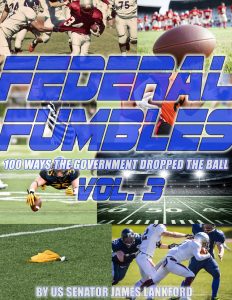Click here to download your free copy: Federal_Fumbles_2017
Our national debt is careening toward $19 trillion (yes, that is a 19 followed by 12 zeros), and federal regulations are expanding at a record pace. Meanwhile families struggle to get home loans, and small businesses struggle to make ends meet. States are constantly handed unfunded mandates and executive fiats that they are forced to implement with minimal direction and no way to pay for them. I present this report as a demonstration of ways we can cut back on wasteful federal spending and burdensome regulations to help families, small businesses, and our economy begin to get out from under the weight of federal stagnation. Cited here are not only prime examples of wasteful spending, but also federal departments or agencies that regulate outside the scope of the federal government’s constitutional role. I firmly believe my staff and I have the obligation to solve the troubles of our nation, not just complain, which is why for every problem identified, you will also find a recommended solution. There is a way to eliminate wasteful, ineffective, or duplicative program spending; develop oversight methods to prevent future waste; and find ways to get us back on track. Sen James Lankford.
The report provides examples of waste and mismanagement that took place over eleven months, including newly documented past waste and ongoing wasteful practices.
The total wasted dollars dug up for the report: $473 billion. In his introduction, Lankford wrote :
Included in ‘Federal Fumbles’ is just a sampling of instances where federal agencies or departments have wasted or inefficiently used billions of your dollars. The program and grant funding discussed in this book has already been allocated or spent and cannot be recovered. But highlighting it here provides lessons for agencies and hopefully encourages Congress to utilize its oversight and legislative authority to prevent future waste and misuse of federal tax dollars.
Lankford said the report should be utilized by members of Congress to curtail the waste and make sure federal agencies “are doing the right thing, the right way.”
The report is based on government oversight agencies, including inspectors general for each federal agency and the Government Office of Accountability (GOA). Here are some random ones from the book.
Unused Vehicles: $1.6 Billion — The Departments of Defense, Homeland Security, Agriculture, Justice, Interior and other agencies purchased an estimated 64,500 passenger vehicles, with $25,600 as the average cost for one vehicle. A GOA review of three agencies revealed there is no way to confirm if any of the vehicles were used.
Trolley Expansion: $1.04 Billion — Last year the Department of Transportation awarded a $1.04 billion grant to extend a trolley line in San Diego, California, by 10.9 miles. The report noted that a billion dollars could pay for hundreds of miles of four-lane highways across the country.
Lost Military Equipment: $1 Billion — The Office of Inspector General at the Department of Defense reported that the agency could not account for more than $1 billion in military equipment, including weapons and military vehicles. Congress appropriated the money for fiscal years 2015 and 2016 to supply equipment to security forces in Iraq.
Chimpanzee Habitat: $52 Million — Over the past 17 years the National Institutes of Health (NIH) has spent more than $52 million to support the Chimpanzee Biomedical Research Resource, despite the fact that the 139 chimpanzees housed through the program are no longer used for biomedical research.
Unused Software: $12 Million — The Internal Revenue Service spent $12 million in 2014 to purchase a two-year subscription to a cloud-based email software to replace its old system. The IG for the Treasury Department said because the software lacked compatibility and other requirements, it was never used.
Fish Research: $2.6 million — Since 2003 the National Science Foundation (NSF) has paid $2.6 million to study the stickleback fish in various habitats, including one to determine how it adapted to murky water in Iceland.
Language Studies: $1,109,792 Million — NSF awarded grants totaling more than $1.1 million dollars to study languages, including the Seenku language from the West African country of Burkina Faso, the four languages of New Guinea and the languages spoken in Nepal’s Manang district.
Mexican Plant Study: $210,968 — The NSF funded a five-year study on native plants from Mexico to determine their role in the indigenous plant trade market.
Higher Ed Aid: $138,000 — The Department of Energy (DOE) helps employees pay for educational courses to improve job skills. DOE paid one engineer $138,000 to take courses unrelated to his job, and he subsequently quit.
Chinese Culture Tour: $100,000 — In 2016 the National Endowments for the Arts (NEA) awarded $100,000 to pay for Chinese troupes to perform in communities across the United States.
Shakespeare Adaptation: $30,000 — An NEA grant was awarded to pay for the production of Doggie Hamlet. Included in the cast were humans, sheep, and dogs but no lines from Hamlet were used in the production.
